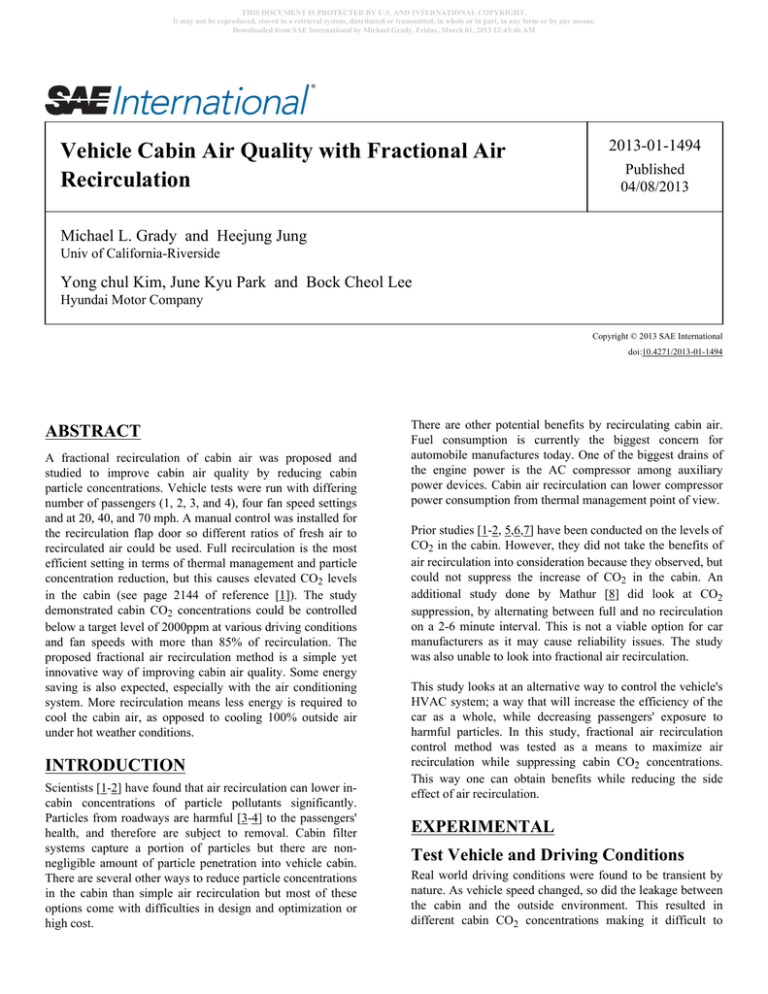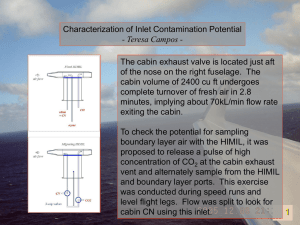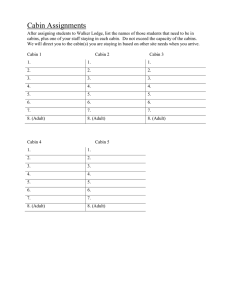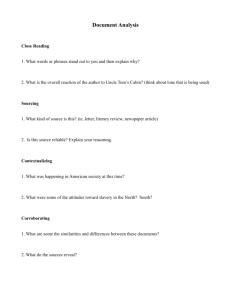
THIS DOCUMENT IS PROTECTED BY U.S. AND INTERNATIONAL COPYRIGHT.
It may not be reproduced, stored in a retrieval system, distributed or transmitted, in whole or in part, in any form or by any means.
Downloaded from SAE International by Michael Grady, Friday, March 01, 2013 12:43:46 AM
Vehicle Cabin Air Quality with Fractional Air
Recirculation
2013-01-1494
Published
04/08/2013
Michael L. Grady and Heejung Jung
Univ of California-Riverside
Yong chul Kim, June Kyu Park and Bock Cheol Lee
Hyundai Motor Company
Copyright © 2013 SAE International
doi:10.4271/2013-01-1494
ABSTRACT
A fractional recirculation of cabin air was proposed and
studied to improve cabin air quality by reducing cabin
particle concentrations. Vehicle tests were run with differing
number of passengers (1, 2, 3, and 4), four fan speed settings
and at 20, 40, and 70 mph. A manual control was installed for
the recirculation flap door so different ratios of fresh air to
recirculated air could be used. Full recirculation is the most
efficient setting in terms of thermal management and particle
concentration reduction, but this causes elevated CO2 levels
in the cabin (see page 2144 of reference [1]). The study
demonstrated cabin CO2 concentrations could be controlled
below a target level of 2000ppm at various driving conditions
and fan speeds with more than 85% of recirculation. The
proposed fractional air recirculation method is a simple yet
innovative way of improving cabin air quality. Some energy
saving is also expected, especially with the air conditioning
system. More recirculation means less energy is required to
cool the cabin air, as opposed to cooling 100% outside air
under hot weather conditions.
INTRODUCTION
Scientists [1-2] have found that air recirculation can lower incabin concentrations of particle pollutants significantly.
Particles from roadways are harmful [3-4] to the passengers'
health, and therefore are subject to removal. Cabin filter
systems capture a portion of particles but there are nonnegligible amount of particle penetration into vehicle cabin.
There are several other ways to reduce particle concentrations
in the cabin than simple air recirculation but most of these
options come with difficulties in design and optimization or
high cost.
There are other potential benefits by recirculating cabin air.
Fuel consumption is currently the biggest concern for
automobile manufactures today. One of the biggest drains of
the engine power is the AC compressor among auxiliary
power devices. Cabin air recirculation can lower compressor
power consumption from thermal management point of view.
Prior studies [1-2, 5,6,7] have been conducted on the levels of
CO2 in the cabin. However, they did not take the benefits of
air recirculation into consideration because they observed, but
could not suppress the increase of CO2 in the cabin. An
additional study done by Mathur [8] did look at CO2
suppression, by alternating between full and no recirculation
on a 2-6 minute interval. This is not a viable option for car
manufacturers as it may cause reliability issues. The study
was also unable to look into fractional air recirculation.
This study looks at an alternative way to control the vehicle's
HVAC system; a way that will increase the efficiency of the
car as a whole, while decreasing passengers' exposure to
harmful particles. In this study, fractional air recirculation
control method was tested as a means to maximize air
recirculation while suppressing cabin CO2 concentrations.
This way one can obtain benefits while reducing the side
effect of air recirculation.
EXPERIMENTAL
Test Vehicle and Driving Conditions
Real world driving conditions were found to be transient by
nature. As vehicle speed changed, so did the leakage between
the cabin and the outside environment. This resulted in
different cabin CO2 concentrations making it difficult to
THIS DOCUMENT IS PROTECTED BY U.S. AND INTERNATIONAL COPYRIGHT.
It may not be reproduced, stored in a retrieval system, distributed or transmitted, in whole or in part, in any form or by any means.
Downloaded from SAE International by Michael Grady, Friday, March 01, 2013 12:43:46 AM
analyze data from transient tests. Thus, the tests were
conducted at constant vehicle speeds with a standard size
SUV provided by Hyundai-Kia motors. Detailed
specifications of the vehicle were not necessary to understand
this study therefore not provided.
Three different speeds were tested: 15, 40 and 70 mph. The
15 mph test was run around the perimeter of a parking lot that
measured 800 ft. by 200 ft. It was manually driven and used
to simulate the slow speeds with heavy traffic during rush
hour. This test was used to investigate influence of passenger
number, ventilation fan speed, and equilibrium CO2
concentration. The 40 and 70 mph tests were run on the five
mile oval at the Hyundai-Kia motor test facility in California
City. Cruise control was used on these tests to maintain the
constant speeds. The 40 and 70 mph tests were used to study
influence of outside winds and vehicle speeds on cabin CO2
concentrations.
The original test vehicle HVAC system controlled air
recirculation; either 0% Recirculated air (fresh, outside air) or
100% recirculated air by changing the opening of the
recirculation door. The HVAC control unit was replaced with
a re-programmed unit which positioned the recirculation door
at a specific angle. This allowed fractional air recirculation at
any percentage from 0-100%. The HVAC vent mode was
fixed at passenger chest mode as opposed to feet mode to
help mixing of CO2 which is heavier than air. Vehicle HVAC
system has an inlet at the floor level and an outlet above the
chest level. This can help mixing of CO2 significantly.
Instruments and Sampling Conditions
CIRAS-2 SC (PP-Systems) was used for the measurement of
cabin CO2 and H2O. It measured both gases at high precision
using NDIR (Non-Dispersive Infrared) technique. The
linearity is better than 1% throughout the range, and the
precision is 3μm/mol for the range used for this study. It had
a built-in auto-zero calibration capability which ensured
stable measurement. Two condensational particle counters
(CPC), model 3776 (TSI), were used to measure particle
concentrations of cabin air and outside air simultaneously.
The outside air was sampled through the right front passenger
window, perpendicular to the flow of the air around the car.
A wood insert with a height of 2 inches was fabricated to
allow the sampling of outside air without compromising the
weathering of the vehicle. Additionally, the insert was used to
create a tight seal between the outside and inside of the
vehicle. A ¼ inch tube was held tight perpendicular to the
wood insert with a bulkhead Swagelok fitting. The tube stuck
out to the window by 2 inches not to be affected by boundary
layer during driving conditions. CPC exhaust was ventilated
out through this insert with a separate hole as not to pollute
the cabin of the vehicle with butanol vapor from the CPC
exhaust.
The inside air was sampled at the shoulder level of a driver
above the center console, facing towards the rear. All
machines were powered by two deep cycle 6V batteries wired
in series with a 1000W inverter. The batteries, CPCs and
CIRAS-2 SC were placed in the trunk of the test vehicle. The
laptops that recorded the data were placed in the back seat.
RESULTS
Feasibility Test: Proof of Concept
Figure 1 shows simultaneous measurement of particle
concentrations inside and outside of the cabin using two
CPCs. The measurements are conducted continuously,
starting at 18:02 (hh:mm) and ending 18:45. The model 3776
CPCs are able to measure particles above 2.5 nm.
The upper curve in the graph shows outside particle
concentration while the lower curve shows particle
concentrations in the vehicle cabin. The curve for the outside
particle concentration shows occasional spikes reflecting
some air parcels which contain a higher concentration of
particles. At the same time, these spikes are not mirrored in
the lower curve. This occurs mainly because of two reasons:
the cabin filter captures those particles and the particles are
diffused and lost to the HVAC duct system. From time 18:02
to 18:16, with 0% recirculation, the cabin air shows particle
concentration reduction by ∼30% compared to that of outside
air. Full (100%) recirculation begins at 18:16. There is an
immediate drop in the particle concentration in the cabin,
which levels out at about 2000 particles/cm3. This is a
significant improvement and greatly diminishes the health
risks that commuters may experience in their cars during rush
hour. It is notable that major spikes in the upper curve are
also seen in the lower curve. These spikes occur at a much
lower concentration and with some time delay when there is
no air recirculation.
This data is taken in the parking lot where outside
concentration is not as dense as that of the highway. Greater
difference in particle concentration is expected between cabin
air and outside air on the highway. Full recirculation allows
the cabin air to pass through the air filtration system multiple
times. This is true for most of commercial cars including the
one used in this study and results in more efficient filtration.
Some energy saving is also expected, especially with the air
conditioning system. More recirculation means less energy is
required to cool the cabin air, as opposed to cooling 100%
outside air under hot weather conditions.
The main problem with having full recirculation is that it
drives up other gas concentrations in the vehicle. Passengers'
breathing generates CO2 and H2O, and it does not take long
for these concentrations to become problematic (more so the
CO2). A higher CO2 concentration has been known to cause
THIS DOCUMENT IS PROTECTED BY U.S. AND INTERNATIONAL COPYRIGHT.
It may not be reproduced, stored in a retrieval system, distributed or transmitted, in whole or in part, in any form or by any means.
Downloaded from SAE International by Michael Grady, Friday, March 01, 2013 12:43:46 AM
Figure 1. Effect of full air recirculation on particle concentration in cabin: comparison with outside air
drowsiness [9] and elevated H2O concentrations requires
more frequent dehumidification of the windshield.
the efficiency and health benefits of full recirculation, while
minimizing CO2 and H2O levels.
Figure 2 shows rise and fall of H2O and CO2 concentrations
under 100 and 0% recirculation conditions for one passenger.
The first full recirculation starts at 13:41 where the CO2 and
H2O concentrations show steep increase until 13:56. Here the
recirculation was changed to 0% (i.e. 100% fresh outside air).
The second full recirculation started at 14:04, showing
similar increase of both CO2 and H2O concentrations until it
ends at 14:18. It is worth to note that both CO2 and H2O
show similar patterns. Their concentrations are subject to
change depending on the strength of sources (i.e. number of
passengers, adult vs. child) and cabin volume.
Characterization of Vehicle HVAC
System
OSHA (Occupational Safety and Health Administration)
enforces a standard CO2 concentration of 5,000 ppm for the
work place [10]. This limit is chosen because at this amount
of exposure, no negative side effects have been noticed.
OSHA also suggests that a CO2 level of 1000ppm indicates
inadequate ventilation for indoors [11]. As the occupancy of a
home or office space is very different from that of a vehicle,
researchers have also referenced a second standard. Mathur
[5] cited ASHRAE standard 62 [12] which specifies the
safety level of CO2 in a conditioned space. The ASHRAE
standard is 700 ppm over ambient conditions on a continuous
basis.
This study proposes a partially recirculated HVAC system (or
fractional air recirculation) as opposed to binary nature of
current systems. The fractional air recirculation could have
The vehicle cabin is relatively well-sealed closed system
except a distinctive inlet (HVAC inlet to draw outside air)
and outlet (so-called body ventilation valve). The majority of
air flow between cabin and outside is through this distinctive
inlet and outlet for ordinarily maintained vehicles. When full
or 100% recirculation is chosen almost all cabin air should
recirculate as the recirculate door will block the passage from
outside. (Note that it is possible some auto manufacturers
may choose to recirculate less than 100% at full recirculation
condition for various reasons with a bypass line. Authors are
not investigating this aspect, nor are they surveying cars from
various auto manufacturers.)
Figure 3 shows increase of cabin CO2 concentration at
various ventilation fan speeds. For this test, two passengers
are in the vehicle that is being driven at 15 mph cruise
condition. For differing fan speeds, CO2 concentrations
plateau at differing values (equilibrium concentrations).
Jung [13] describes that the CO2 concentration reaches
equilibrium due to the balance between CO2 source (exhale
of passengers), and the leakage in and out of the vehicle
cabin. The higher the ventilation speed, the lower the
equilibrium CO2 concentration as shown in Figure 3. This is
because higher ventilation speed creates bigger pressure
difference across recirculation door and closing surface
region. This results in larger leakage into the cabin. Jung [13]
THIS DOCUMENT IS PROTECTED BY U.S. AND INTERNATIONAL COPYRIGHT.
It may not be reproduced, stored in a retrieval system, distributed or transmitted, in whole or in part, in any form or by any means.
Downloaded from SAE International by Michael Grady, Friday, March 01, 2013 12:43:46 AM
Figure 2. Effect of full air recirculation on water vapor and CO2 concentration in cabin with one passenger
Figure 3. Evolution of cabin CO2 concentration as a function of time and fan speed. Test conducted at full recirculation
condition with two passengers
models vehicle cabin CO2 concentration with mathematical
equations applies those to experimental data such as Figure 3
and predicts evolution of CO2 concentrations. The data in
Figure 3 along with a mathematical model provides
characteristic parameters of the vehicle cabin HVAC system
to control cabin CO2 concentration at certain level.
Feasibility Test: Manual Control (PreStep to Auto Control)
Full or 100% recirculation corresponds to the HVAC
recirculation door being closed, allowing no outside air into
the cabin. Likewise, 0% recirculation corresponds to this door
being completely open, drawing fresh air from the outside.
As a preface to implementing CO2 concentration control
THIS DOCUMENT IS PROTECTED BY U.S. AND INTERNATIONAL COPYRIGHT.
It may not be reproduced, stored in a retrieval system, distributed or transmitted, in whole or in part, in any form or by any means.
Downloaded from SAE International by Michael Grady, Friday, March 01, 2013 12:43:46 AM
logic to the vehicle HVAC system, manual control tests are
conducted.
A CO2 control cycle for feasibility test begins with full
recirculation and then opens the recirculation door partially to
maintain the upslope at slightly positive value. The test then
cycles with a second recirculation door angle which exhibits
the slight downslope. This is to maintain the CO2
concentration at a target range of concentrations. Different
ventilation speeds create varying amounts of body leakage.
This results in the need for the fraction of air recirculation,
which is determined by the recirculation door angle, to be
adjusted to a different level. For example a faster ventilation
fan speed results in more body leakage flow. Therefore the
fraction of outside air needs to be less compared to that of a
slower ventilation fan speed.
Figure 4 shows cabin CO2 concentrations that are maintained
within a target range of concentrations for different
ventilation fan speeds. The process described above is used to
achieve the same level of CO2 concentration. The
recirculation door control was done manually by providing
DC power to the actuator which controls the position of the
recirculation door.
Figure 4. (cont.) Feasibility test to control cabin CO2
concentration at a target level of 2000 ppm, at 15 mph
with two passengers. Different fan speeds were tested:
(a.) Fan Speed 2 is slow; (b.) Fan Speed 4 is medium and
(c.)Fan Speed 6 is fast. Percentage indicates degree of
recirculation
Influence of Vehicle Speed
Figure 5. Influence of vehicle speed on cabin CO2
concentration control. Both tests had two passengers and
used Fan Speed 2 with the vehicle driven at 40 mph (top
line) and 70 mph (bottom line)
Figure 4.
The final variable that is tested is vehicle speed. This has a
big effect on vehicle leakage due to the higher pressure
outside of the vehicles at high speeds. Tests for speeds of 40
and 70 mph, Figure 5, are recorded with the same algorithm
for voltages as the 15 mph test shown in Figure 4. The fan
speed is fixed at level 2 and the number of passengers is also
fixed at two people. Higher speeds cause more leakage which
cause variable recirculation to have less of an impact on CO2
concentrations. In other words CO2 concentrations are
maintained below target concentrations due to strong body
leakage from outside of the vehicle. It should be noted that
the vehicle was driven the oval track at Hyundai's test track.
Any possible effect of wind direction is not noted therefore it
THIS DOCUMENT IS PROTECTED BY U.S. AND INTERNATIONAL COPYRIGHT.
It may not be reproduced, stored in a retrieval system, distributed or transmitted, in whole or in part, in any form or by any means.
Downloaded from SAE International by Michael Grady, Friday, March 01, 2013 12:43:46 AM
is assumed the wind effect is canceled out due to the circular
driving pattern of the vehicle.
Input Parameters to Control Cabin CO2
Concentrations.
It is always possible to do a feedback control of cabin air
recirculation by means of CO2 sensor. This study, along with
Jung's [13] modeling result, suggests an open loop control is
possible if characteristics of vehicle cabin air system are
determined, allowing the car manufacturer to save the CO2
sensor cost without hampering the cabin occupants health.
There are four important parameters which determine vehicle
cabin CO2 concentration as shown in Figure 6. Sensitivity
and relative importance of each parameter varies depending
on vehicle conditions. These can be determined by
combination of well-designed experiments and model
equations. More specific and detailed applications (such as
full characterization of a specific vehicle cabin air system
and/or determining sensitivity and relative importance of
each input parameter for control purpose) of the fractional
recirculation are possible but it is a subject for future study.
This study achieved its goal demonstrating feasibility and
benefits of fractional air recirculation system.
CO2 concentration is determined by the balance between
source strength (or number of passengers) and body leakage
rate (flow rates in and out of the vehicle). This balance is
influenced by multiple parameters: vehicle speed, cabin
volume, recirculation, fan speed and number of passengers.
Body leakage rates are vehicle specific and need to be fully
characterized for the vehicle of interest.
The study aimed to control cabin CO2 concentrations at
certain levels by adjusting the opening of the recirculation
door angle. For example, with more than 85% of
recirculation, cabin CO2 concentration of 2000ppm could be
obtained for two passengers at various driving conditions and
fan speeds. We believe this method is a cost effective way of
maintaining clean air quality of the cabin and can be
applicable to new cars.
It is known that people get highest exposure to particle
pollutants on roadways during their commute. The proposed
fractional air recirculation system can contribute to reducing
health risks of vehicle passengers by particle pollutants on
roadways. The suggested fractional air recirculation method
is a simple yet innovative, and easily implementable way of
improving cabin air quality.
REFERENCES
1. Zhu, Y., Eiguren-Fernandez A., et al. (2007). “In-Cabin
Commuter Exposure to Ultrafine Particles on Los Angeles
Freeways.” Environmental Science & Technology 41(7):
2138-2145.
2. Qi, C., Stanley N., et al. (2008). “Laboratory and OnRoad Evaluations of Cabin Air Filters Using Number and
Surface Area Concentration Monitors.” Environmental
Science & Technology 42(11): 4128-4132.
Figure 6. Schematic of control logic
CONCLUSION
Passengers currently can choose either full air-recirculation
or outside air for ventilation. This study suggests fractional
air recirculation can keep the benefits of full recirculation
(reduction of particle pollutant concentrations in cabin and
reduction in AC power consumption), while suppressing side
effects (increase of cabin CO2 and H2O level).
The study demonstrated the effects of air recirculation on
cabin particle concentrations, water vapor and CO2. Cabin
particle concentrations were reduced to 20% of 0%
recirculation air with 100% air recirculation, while CO2 and
water vapor concentrations increased steeply.
The study proposed a fractional air recirculation to suppress
the increase of the cabin CO2 concentration. It showed cabin
3. Pope CA, Dockery DW. Health effects of fine particulate
air pollution: lines that connect. J Air Waste Manag Assoc.
2006;56:709-742.
4. Seaton A, MacNee W, Donaldson K, Godden D.
Particulate air pollution and acute health effects. Lancet.
1995;345:176-178.
5. Mathur, G., “Field Tests to Monitor Build-up of Carbon
Dioxide in Vehicle Cabin with AC System Operating in
Recirculation Mode for Improving Cabin IAQ and Safety,”
SAE Int. J. Passeng. Cars - Mech. Syst. 1(1):757-767, 2009,
doi:10.4271/2008-01-0829.
6. Mathur, G., “Field Monitoring of Carbon Dioxide in
Vehicle Cabin to Monitor Indoor Air Quality and Safety in
Foot and Defrost Modes,” SAE Technical Paper
2009-01-3080, 2009, doi:10.4271/2009-01-3080.
7. Mathur, G., “Measurement of Carbon Dioxide in Vehicle
Cabin to Monitor IAQ during Winter Season with HVAC
Unit Operating In OSA Mode,” SAE Technical Paper
2009-01-0542, 2009, doi:10.4271/2009-01-0542.
THIS DOCUMENT IS PROTECTED BY U.S. AND INTERNATIONAL COPYRIGHT.
It may not be reproduced, stored in a retrieval system, distributed or transmitted, in whole or in part, in any form or by any means.
Downloaded from SAE International by Michael Grady, Friday, March 01, 2013 12:43:46 AM
8. Mathur, G., “Field Tests to Monitor Build-up of Carbon
Dioxide in Vehicle Cabin with AC System Operating in
Recirculation Mode for Improving Cabin IAQ and Safety,”
SAE Int. J. Passeng. Cars - Mech. Syst. 1(1):757-767, 2009,
doi:10.4271/2008-01-0829.
9. NIOSH. Criteria for a Recommended Standard…
Occupational Exposure to Carbon Dioxide (Pub. No. 76-194).
Cincinnati, OH: NIOSH (DHHS), 1975
10. U.S. Department of Labor, Occupational Safety and
Health Administration. Code of Federal Regulations, Title 29,
Part 1910.1000-1910.1450. www.osha.gov.
11. U.S. Department of Labor, Occupational Safety and
Health Administration. OSHA Technical Manual. TED
01-00-015. www.osha.gov.
12. ASHRAE/ANSI, Standard 62-1999 (1999), Ventilation
for acceptable indoor air quality, American Society of
Heating, Refrigerating and Air Conditioning Engineers., Inc.,
Atlanta, GA
ACKNOWLEDGMENTS
HJ and MG gratefully acknowledge Hyundai-Kia motors to
provide a test vehicle and funding for this study. HJ and MG
are also grateful to Mike Todd, Joseph Menke at CE-CERT,
Johnny Wang, Eli Brewer, Daisy Jimenez from UCR for
assisting with tests, and Lee Foster, Sekil Park from HyundaiKia motors. HJ is also grateful to Moonsoo Park from NGV.
DEFINITIONS/ABBREVIATIONS
HVAC - heating ventilation and air conditioning
NDIR - nondispersive infrared sensor
CPC - condensation particle counter
DC - direct current
AC - air condistioning
NIOSH - national institute for occupational safety and health
OSHA - occumational safety and health administration
13. Jung, H., “Modeling CO2 Concentration in Vehicle
Cabin Air,” SAE Technical Paper 2013-01-1497, 2013, doi:
10.4271/2013-01-1497.
CONTACT INFORMATION
Corresponding author:
Heejung Jung
heejung@engr.ucr.edu
The Engineering Meetings Board has approved this paper for publication. It has
successfully completed SAE's peer review process under the supervision of the session
organizer. This process requires a minimum of three (3) reviews by industry experts.
All rights reserved. No part of this publication may be reproduced, stored in a
retrieval system, or transmitted, in any form or by any means, electronic, mechanical,
photocopying, recording, or otherwise, without the prior written permission of SAE.
ISSN 0148-7191
Positions and opinions advanced in this paper are those of the author(s) and not
necessarily those of SAE. The author is solely responsible for the content of the paper.
SAE Customer Service:
Tel: 877-606-7323 (inside USA and Canada)
Tel: 724-776-4970 (outside USA)
Fax: 724-776-0790
Email: CustomerService@sae.org
SAE Web Address: http://www.sae.org
Printed in USA





